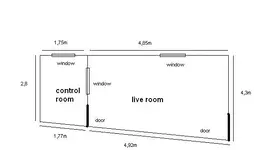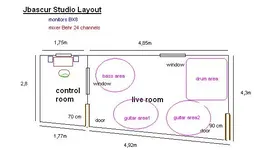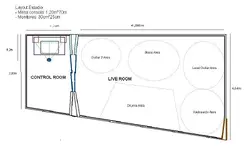Hello jbascur and welcome to the board. Ok, I have a suggestion. First, MY STANDARD DISCLAIMER:
DISCLAIMER: I, Rick Fitzpatrick, under no circumstances, or in no way, shape or form, claim to be any sort of STUDIO CONSTRUCTION OR ACOUSTICS expert, know it all, Harry Potter or other wizard, specialist, or professional, nor am I experienced in any physical construction of real studios, practice rooms, control rooms, home theaters, vocal booths, or other construction requiring extreme sound transmission loss or special acoustical treatment. NONE. PERIOD. ZERO. ZILCH. I also have NO CREDENTIALS, DEGREE, DIPLOMA, CERTIFICATE, BADGE, ARM PATCH, or even a damn reputation for knowing what I am talking about. ARE WE CLEAR?

Good. Then I will give you my .02, and thats it. OK? OK.

IF, your live room is not going to be used day in day out for recording bands, I would make the control room the priority as far as monitoring is concerned., Here is what I would do. The distance from the front control room wall is 1.75 meters. This is only 5.8 feet. TOO SHORT. By the time you put a console, and chair in there you will have less than 24 inchs from your ears to the back wall. Terrible as comb filtering from reflections off the back wall will alter your perception of what you are hearing in the monitors. I would increase this dimension to at LEAST 12 feet if not more. Here is why.
A microphone in the studio pics up not only the direct sound from the source, and a short time later, reflections from the ceiling, floor, and walls arrive at the mic. This TIME delay creates what is known as COMB FILTERING. ALL recordings are stamped to some degree with this sonic character of the mic placement. In order for the engineer to HEAR these reflections, his monitoring position in the control room must be in a REFLECTION FREE ZONE. The reason is simple. If you are not in a RFZ, your evaluation of the sound in the studio will NOT be correct. AND, reflections off the front and side walls, and ceilings in the control room will also create COMB FILTERING. Hence the use of absorbers at the front and side or splayed walls.
In order to create a RFZ, you need some things. First, the side walls and ceiling must have absorption placed in such a way as to absorb early reflections, OR be splayed in such a way, that direct the reflections toward the rear wall, which is far enough back to create what is known as an INITIAL TIME DELAY GAP.(TDG)
This TDG, is what allows you to HEAR the reflections that the microphone is picking up in the studio FIRST. Otherwise, among other things, the reflections in the control room will mask these studio reflections, thereby altering your perception of what is really being recorded. This TDG, SHOULD be at least 20 milliseconds longer than that of the studio, as the brain will integrate sounds that arrive within 20ms of each other. This translates into specific minimum distance. Since sound travels at appox 1130 feet per second, or about 1 ft per millisecond, to create a minimum gap of 20ms, the direct sound must travel about 20 feet round trip, from your ears- to the rear wall- and back to your ears. Given that sound decays 6db for every doubling of distance, by the time it reflects off the rear wall(not accounting for absorption) and returns, it has also decayed at least 6db.(10ft to rear wall, 10 ft return) Which further allows distinction between direct sound from the monitors, and reflections. Furthermore, this reflection off the rearwall, SHOULD be of a broadband diffusive quality, so as not to absorb energy from the modal response of the room, as modal decay varies.(SEE DISCLAIMER) However, there are some who suggest that small room diffuse fields do not exist. So, take it with a grain of salt. Most designers today regard diffusers as a device to use in LARGE ROOMS, and the use of SLAT ABSORBERS works much better in small control room rear walls. I'll leave the decision to the owners

But for most small home studio owners, control rooms with a TDG distance is a luxury. Most must make do with a much shorter distance to the rear wall. In that case, it is preferable to line the rear wall and corners with DEEP absorbers, such as 4" or 6" OWENS CORNING 703 rigid fiberglass panels, mounted at least 2" off the wall. And this is just the tip of the design iceberg. Also to take in consideration is modal NULLS. I won't pretend to be a novice,(disclaimer) let alone an expert on this stuff. You've alread been given a link to an experts website, so I'll leave that to them. It is of much importance that you understand that your monitoring success is at stake right from the getgo as far as design is concerned though. If it were me, I would use some of the live room square footage to enlarge the control room, although, prioritizing this is your domain. Good luck. Oh, btw, since this is in the planning stage, make your CEILINGS as HIGH as you can afford.
fitZ



 Good. Then I will give you my .02, and thats it. OK? OK.
Good. Then I will give you my .02, and thats it. OK? OK.


